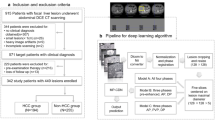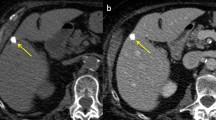Abstract
Objectives
To compare the performance of current guidelines applicable to the diagnosis of hepatocellular carcinomas (HCCs) using gadoxetic acid–enhanced magnetic resonance imaging (MRI).
Methods
Two hundred and forty-one hepatic lesions (149 HCCs, six other malignancies, 86 benign lesions) in 177 patients at risk of HCC without a history of previous treatment for hepatic malignancy in a tertiary center were retrospectively reviewed. Either histopathology results or long-term (> 24 months) follow-up images were used as a standard of reference. All lesions were categorized according to the Liver Imaging Reporting and Data System (LI-RADS), European Association for the Study of the Liver (EASL), Asian Pacific Association for the Study of the Liver (APASL), and Korean Liver Cancer Study Group-National Cancer Center (KLCSG-NCC) guidelines. The sensitivity and specificity thereof were assessed using a generalized estimation equation.
Results
For gadoxetic acid–enhanced MRI, LI-RADS (95%, 95% confidence interval [CI] 88–98) and EASL (94%, 95% CI 86–97) yielded the highest specificity, while EASL yielded the lowest sensitivity (54% [95% CI 46–62]). APASL yielded the highest sensitivity (91% [95% CI 86–95]) with the lowest specificity (78% [95% CI 69–86]). KLCSG-NCC showed balanced sensitivity (85% [79–90]) and specificity (88% [95% CI 80–93]). Differences were more prominent in small nodules between 1 and 2 cm.
Conclusion
The diagnostic performance of current guidelines for HCC on gadoxetic acid–enhanced MRI was significantly different, and a potential inverse association between sensitivity and specificity was observed.
Key Points
• EASL and LI-RADS yielded the highest specificity with the lowest sensitivity, whereas APASL yielded the highest sensitivity with the lowest specificity.
• Differences in the diagnostic performances of guidelines were prominent in small nodules between 1 and 2 cm.
• Additional evaluation of CT findings improved the diagnostic sensitivity and accuracy of EASL and LI-RADS. Although doing so decreased specificity, it remained above 89–90%.




Similar content being viewed by others
Abbreviations
- AASLD:
-
American Association for the Study of Liver Disease
- APASL:
-
Asian Pacific Association for the Study of the Liver
- CEUS:
-
Contrast-enhanced ultrasonography
- cHCC-CC:
-
Combined hepatocellular carcinoma-cholangiocarcinoma
- CI:
-
Confidence interval
- CT:
-
Computed tomography
- EASL:
-
European Association for the Study of the Liver
- ECA:
-
Extracellular contrast agent
- HCC:
-
Hepatocellular carcinoma
- KLCSG-NCC:
-
Korean Liver Cancer Study Group-National Cancer Center
- LI-RADS:
-
Liver Imaging Reporting and Data System
- MRI:
-
Magnetic resonance imaging
References
European Association for the Study of the Liver (2018) EASL Clinical Practice Guidelines: management of hepatocellular carcinoma. J Hepatol 69:182–236
Heimbach JK, Kulik LM, Finn RS et al (2018) AASLD guidelines for the treatment of hepatocellular carcinoma. Hepatology 67:358–380
Marrero JA, Kulik LM, Sirlin CB et al (2018) Diagnosis, staging, and management of hepatocellular carcinoma: 2018 practice guidance by the American Association for the Study of Liver Diseases. Hepatology 68:723–750
Kamath A, Roudenko A, Hecht E et al (2019) CT/MR LI-RADS 2018: clinical implications and management recommendations. Abdom Radiol (NY) 44:1306–1322
Omata M, Cheng AL, Kokudo N et al (2017) Asia-Pacific clinical practice guidelines on the management of hepatocellular carcinoma: a 2017 update. Hepatol Int 11:317–370
Korean Liver Cancer Association, National Cancer Center (2019) 2018 Korean liver cancer association-national cancer center Korea practice guidelines for the management of hepatocellular carcinoma. Gut Liver 13:227–299
Hwang S, Lee SG, Belghiti J (2010) Liver transplantation for HCC: its role: Eastern and Western perspectives. J Hepatobiliary Pancreat Sci 17:443–448
Venook AP, Papandreou C, Furuse J, de Guevara LL (2010) The incidence and epidemiology of hepatocellular carcinoma: a global and regional perspective. Oncologist 15(Suppl 4):5–13
Erkan B, Meier J, Clark TJ, Kaplan J, Lambert JR, Chang S (2019) Non-invasive diagnostic criteria of hepatocellular carcinoma: comparison of diagnostic accuracy of updated LI-RADS with clinical practice guidelines of OPTN-UNOS, AASLD, NCCN, EASL-EORTC, and KLSCG-NCC. PLoS One 14:e0226291
Lee S, Kim MJ, Kim SS et al (2020) Retrospective comparison of EASL 2018 and LI-RADS 2018 for the noninvasive diagnosis of hepatocellular carcinoma using magnetic resonance imaging. Hepatol Int 14:70–79
Hwang SH, Park S, Han K, Choi JY, Park YN, Park MS (2019) Optimal lexicon of gadoxetic acid-enhanced magnetic resonance imaging for the diagnosis of hepatocellular carcinoma modified from LI-RADS. Abdom Radiol (NY) 44:3078–3088
Theise ND, Curado MP, Franceschi S (2010) Hepatocellular carcinoma. In: Bosman FT, Carneiro F, Hruban RH, Theise ND (eds) WHO classification of tumours of the digestive system. International agency of research on cancer, Lyon, pp 205–216
Landis JR, Koch GG (1977) The measurement of observer agreement for categorical data. Biometrics 33:159–174
Choi JY, Lee JM, Sirlin CB (2014) CT and MR imaging diagnosis and staging of hepatocellular carcinoma: part I. Development, growth, and spread: key pathologic and imaging aspects. Radiology 272:635–654
Kim TH, Kim SY, Tang A, Lee JM (2019) Comparison of international guidelines for noninvasive diagnosis of hepatocellular carcinoma: 2018 update. Clin Mol Hepatol 25:245–263
Joo I, Lee JM, Lee DH, Jeon JH, Han JK (2018) Retrospective validation of a new diagnostic criterion for hepatocellular carcinoma on gadoxetic acid-enhanced MRI: can hypointensity on the hepatobiliary phase be used as an alternative to washout with the aid of ancillary features? Eur Radiol. https://doi.org/10.1007/s00330-018-5727-1
Min JH, Kim JM, Kim YK et al (2018) Prospective intraindividual comparison of magnetic resonance imaging with gadoxetic acid and extracellular contrast for diagnosis of hepatocellular carcinomas using the liver imaging reporting and data system. Hepatology 68:2254–2266
Kim DH, Choi SH, Kim SY, Kim MJ, Lee SS, Byun JH (2019) Gadoxetic acid-enhanced MRI of hepatocellular carcinoma: value of washout in transitional and hepatobiliary phases. Radiology 291:651–657
Choi SH, Byun JH, Lim YS et al (2016) Diagnostic criteria for hepatocellular carcinoma 3 cm with hepatocyte-specific contrast-enhanced magnetic resonance imaging. J Hepatol 64:1099–1107
Furlan A, Marin D, Vanzulli A et al (2011) Hepatocellular carcinoma in cirrhotic patients at multidetector CT: hepatic venous phase versus delayed phase for the detection of tumour washout. Br J Radiol 84:403–412
Iannaccone R, Laghi A, Catalano C et al (2005) Hepatocellular carcinoma: role of unenhanced and delayed phase multi-detector row helical CT in patients with cirrhosis. Radiology 234:460–467
Vitale A, Peck-Radosavljevic M, Giannini EG et al (2017) Personalized treatment of patients with very early hepatocellular carcinoma. J Hepatol 66:412–423
Huang B, Wu L, Lu XY et al (2016) Small intrahepatic cholangiocarcinoma and hepatocellular carcinoma in cirrhotic livers may share similar enhancement patterns at multiphase dynamic MR imaging. Radiology 281:150–157
van der Pol CB, Lim CS, Sirlin CB et al (2019) Accuracy of the Liver Imaging Reporting and Data System in computed tomography and magnetic resonance image analysis of hepatocellular carcinoma or overall malignancy-a systematic review. Gastroenterology 156:976–986
Lee HS, Kim MJ, An C (2019) How to utilize LR-M features of the LI-RADS to improve the diagnosis of combined hepatocellular-cholangiocarcinoma on gadoxetate-enhanced MRI? Eur Radiol 29:2408–2416
Funding
This study has received funding by the National Health Insurance Service Ilsan Hospital grant NHIMC 2018CR091.
Author information
Authors and Affiliations
Corresponding author
Ethics declarations
Guarantor
The scientific guarantor of this publication is Mi-Suk Park.
Conflict of interest
The authors of this manuscript declare no relationships with any companies, whose products or services may be related to the subject matter of the article.
Statistics and biometry
No complex statistical methods were necessary for this paper.
Informed consent
Written informed consent was waived by the Institutional Review Board.
Ethical approval
Institutional Review Board approval was obtained.
Study subjects or cohorts overlap
All study subjects have been previously reported in Abdom Radiol (2019;44:3078–3088). However, the objective of the present study, comparison of diagnostic performance of current guidelines for HCC, is different from the previous study.
Methodology
• retrospective
• diagnostic or prognostic study
• performed at one institution
Additional information
Publisher’s note
Springer Nature remains neutral with regard to jurisdictional claims in published maps and institutional affiliations.
Supplementary Information
ESM 1
(DOCX 19 kb)
Rights and permissions
About this article
Cite this article
Hwang, S.H., Park, MS., Park, S. et al. Comparison of the current guidelines for diagnosing hepatocellular carcinoma using gadoxetic acid–enhanced magnetic resonance imaging. Eur Radiol 31, 4492–4503 (2021). https://doi.org/10.1007/s00330-020-07468-3
Received:
Revised:
Accepted:
Published:
Issue Date:
DOI: https://doi.org/10.1007/s00330-020-07468-3




